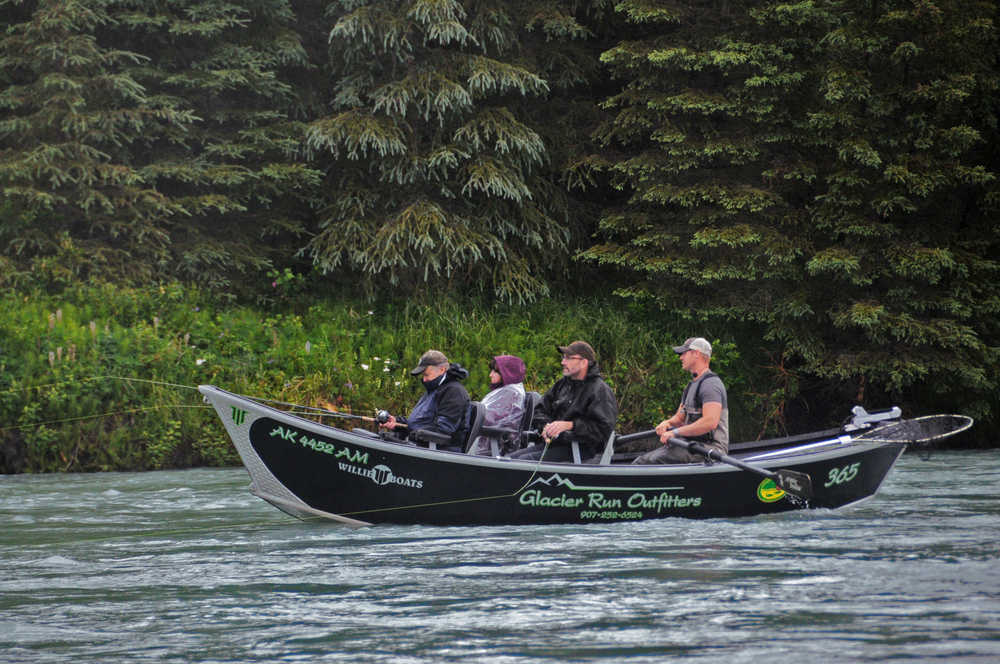High water levels on the Kenai and Russian rivers have made fishing slow on the Kenai so far this summer.
With above-average snowmelt in the mountains coming down into the rivers, the Kenai far fuller than usual and the Russian River in the 90th percentile of its usual flow, according to the U.S. Geological Survey’s data. On top of that, the Kenai River has been very murky, making catch rates for king salmon virtually zero on the Kenai, said Jason Pawluk, the acting area management biologist for the Alaska Department of Fish and Game’s Division of Sportfish in Soldotna.
The high water does seem to be peaking, and as the levels recede to normal, fishing success might improve. The same is true as water clarity improves, he said.
However, the early run of sockeye salmon to the Russian River appears to have peaked and came out smaller than expected. As of Tuesday, 20,075 fish had passed through the weir at Lower Russian Lake, a little more than half of the 37,084 that had passed the weir by this time last year. It appears that the peak of the run has passed, Pawluk said.
“Based on this morning’s passage, I think we’re going to continue to drop,” Pawluk said. “It doesn’t mean you can’t still catch fish, but you may have to work for it.”
Fish and Game does not plan to issue any restrictions on harvest on the Russian River sockeye, as it appears the run will meet its escapement goal, he said.
The Kenai’s early run of king salmon surpassed the upper end of its optimum escapement goal of 9,000 fish Monday, with three days left to go. Harvest has been minimal, primarily because of bad water conditions, though anglers have caught a few, Pawluk said.
Harvest on the late run of Kenai River king salmon will open Friday, with a few restrictions. Anglers won’t be able to use bait on the Kenai River from the mouth upstream to the outlet of Skilak Lake from July 1–31, according to an emergency order issued by Fish and Game June 24.
Fishermen can only use one single hook, artificial fly or lure on that part of the river. However, the rules will differ in two different sections of the river: from the mouth upstream to a marker 300 yards downstream of the mouth of Slikok Creek, anglers can retain king salmon of any size. Upstream from that marker to the outlet of Skilak Lake, anglers are limited to keeping king salmon less than 42 inches or greater than 55 inches long from July 1–14. After July 15, the regulations will be the same in both sections.
Pawluk said although the projected run is 30,000, after calculating harvest among the marine and inriver fishery as well as expected harvest by the east side setnets, the bait restriction will help ensure the number of fish in the river fulfill the minimum escapement goal.
On the Kasilof River, catch rates are declining again after a rise when Fish and Game opened the river to bait. Some anglers are still catching kings from the river and sockeye are increasingly moving up into the river, but it is possible that many of the kings have moved up into Crooked Creek, Pawluk said. At the mouth, the personal use dipnet fishery opened last Saturday, but catch rates were low.
“We haven’t really seen the counts come back up yet, but there’s still some fish being landed,” he said.
On the eastern side of the peninsula, anglers in Seward are wrapping up the annual halibut tournament. As of Wednesday afternoon, the leading fish — caught on June 25 by Big Lake angler Pat Daniels aboard a J-Dock Charters vessel — weighed in at 191.2 pounds. The tournament concludes Thursday, so hopefuls can still enter their fish until Thursday evening. The fisherman with the biggest fish will win $1,000, with second and third places claiming $500 and $250, respectively.
Lingcod fishing will also open on the North Gulf Coast on July 1, though not in Resurrection Bay — any angler who takes a lingcod at all cannot fish for any species in the bay, according to the 2016 Sport Fishing Regulations Summary.
King salmon, pacific cod, rockfish and some coho are being caught in the Resurrection Bay area. The only fresh water fishing available in Seward is a small section of Resurrection Creek, from a regulatory marker upstream of the mouth upstream to the Seward Highway bridge, as well as some Seward Creeks and First Lake, where rainbow trout can be caught.
Reach Elizabeth Earl at elizabeth.earl@peninsulaclarion.com.

